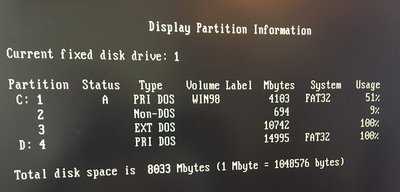First post, by Tenorman
- Rank
- Newbie
Hello All,
Hoping this is something silly, but I haven't been able to figure it out. I have two FAT32 partitions. If I reboot to MS-DOS mode and try to access drive D:, I get "invalid drive specification".
My CD-ROM drive is being assigned letter E: successfully and the drive D: is listed in fdisk's output. LASTDRIVE is set to H: so that shouldn't be an issue either.
Thanks.
FDISKFixed Disk Drive StatusDisk Drv Mbytes Free Usage1 8033 100%C: 4103D: 14995AUTOEXEC.BAT-------SET TMP=C:\TEMPSET TEMP=C:\TEMPSET PROMPT=$p$gSET winbootdir=C:\WINDOWSSET PATH=C:\SB16;C:\SNDSCAPE;C:\UTILS;C:\WINDOWS;C:\WINDOWS\COMMANDSET SNDSCAPE=C:\SNDSCAPESET SOUND=C:\SB16SET BLASTER=A220 I7 D1 H5 P300 E620 T6SET MIDI=SYNTH:1 MAP:E MODE:0SET CTCM=C:\CTCM@ECHO ONCALL C:\SNDSCAPE\INITSS.BATC:\CTCM\CTCM.EXEC:\SB16\DIAGNOSE /SC:\SB16\AWEUTIL /SC:\SB16\MIXERSET /P /QLH C:\UTILS\CTMOUSE.EXE /R2LH DOSKEY.COMGoTo %config%:EMC:XMC:CMCLH C:\WINDOWS\COMMAND\MSCDEX.EXE /D:OPTICAL /L:E:EM:XM:CMCONFIG.SYS-------[COMMON]DOS=NOAUTODOS=HIGH,UMBFILES=40BUFFERS=30LASTDRIVE=HDEVICE=C:\WINDOWS\SETVER.EXE[menu]menuitem=EMC, Expanded memory + Mouse + CD-ROMmenuitem=XMC, Extended memory + Mouse + CD-ROMmenuitem=CMC, Conventional Memory only + Mouse + CD-ROMmenuitem=EM, Expanded memory + Mousemenuitem=XM, Extended memory + Mousemenuitem=CM, Conventional memory only + Mousemenudefault=EMC,10[EMC]DEVICE=C:\WINDOWS\HIMEM.SYS /TESTMEM:OFF
DEVICE=C:\WINDOWS\EMM386.EXE RAMDEVICEHIGH=C:\UTILS\VIDECDD.SYS /D:OPTICAL[XMC]DEVICE=C:\WINDOWS\HIMEM.SYS /TESTMEM:OFFDEVICEHIGH=C:\UTILS\VIDECDD.SYS /D:OPTICAL[CMC]DEVICEHIGH=C:\UTILS\VIDECDD.SYS /D:OPTICAL[EM]DEVICE=C:\WINDOWS\HIMEM.SYS /TESTMEM:OFFDEVICE=C:\WINDOWS\EMM386.EXE RAM[XM]DEVICE=C:\WINDOWS\HIMEM.SYS /TESTMEM:OFF[CM]
[Compaq Presario 633 | DOS 6.22 / Win 3.1 | DX4 100 Overdrive | 28M RAM | SB16 CT2770A | SPEA Media FX (Soundscape S2000) ]
[GA-6BXC R2.0 | Win98SE | Via C3 Ezra 866 | 384M RAM | TNT2 32M | Voodoo2 8M | SB32 CT3670 | Ensoniq Soundscape Opus]




